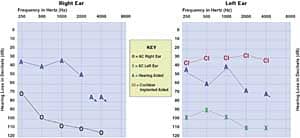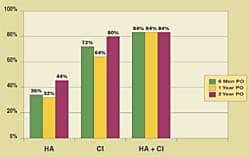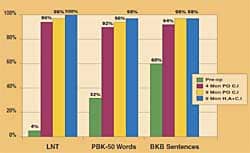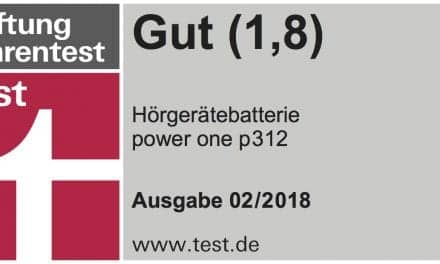While spending the weekend with my father, I had the opportunity to see a friend of my parents whom I hadn’t seen in 30 years. I remembered her from my childhood, and I really looked forward to seeing her again. Unfortunately, she missed most of what I said. At one point in the conversation, she mentioned that she had tried a hearing aid 12 years ago, but did not keep it because it worked so poorly in background noise. I tried to tell her about improvements in the field, but she explained that her friends with new hearing aids had the same complaints.


Figure 1. Link-it array microphone devices can be used with ITE (left) and BTE (right) hearing aids that have built-in telecoils. |
I felt sad knowing that a hearing aid with a directional microphone or an assistive listening device, such as an array microphone or FM system, could completely change her life. Unfortunately, she is part of the nearly 80% of people who report hearing difficulty but do not use hearing instruments.1 She seems likely to stay in that group, despite my urging her to give hearing aids another try.
Additionally, I received a call from my sister-in-law’s father. As he had done several times in the past, he inquired about the latest in hearing aid technology. (He has worn programmable analog hearing aids for the past 10 years.) At the time he purchased these aids, they were considered state-of-the-art. Unfortunately, he has never been truly satisfied with them, even though he wears them most of the time. His biggest complaint is his inability to hear in noisy situations, and he avoids noisy places and groups of people because he cannot communicate in such an environment.
These two experiences, related by author, Laurel A. Christensen, PhD, share one fact: both individuals complained about their inability to hear in noise, one of the most common complaints of hearing aid users.2 Fortunately, in the past 5 years, solutions to this problem have been developed. The better directional microphone hearing aids can return many users to normal ability to understand speech in noise.3 Unfortunately, these solutions are underutilized by dispensing professionals. In fact, only an estimated 10% of hearing aids dispensed in the US include directional microphones (estimate from industry data).
Much has been written about the benefits of directional microphone hearing aids and how to fit these devices. Then why are directional microphones so seldom ordered? We offer the following possibilities:
1) Until recently, hearing aids with directional microphones were only available in BTE and full-shell ITE styles, and few dispensing professionals realize that a 5 dB signal-to-noise ratio (SNR) improvement is now available in mini-canal sizes;
2) Most dispensing professionals do not know how to evaluate a patient’s SNR loss (the reduced ability to hear in noise), even though excellent tests are available;4,5
3) Some hearing aids with directional microphones are not very directional. We have measured 14 ITE hearing aids with directional microphones. Their directivity, or SNR improvement, varied from 2.2 to 5.1 dB;
4) The interaction between venting, low frequency response, and directivity is not well understood. Some hearing aids roll off the lows in the directional mode. Without sufficient low-frequency gain to overcome the noise entering through the vent, patients with low-frequency loss: a) become deprived of low-frequency cues; and b) lose the directional advantage at low frequencies;6
5) Until now there has been no practical head-worn device for the estimated 35% of patients whose SNR loss falls between 5 dB and the 15 dB that requires an FM system.
The Link-it™ array microphone system is designed to provide approximately twice the directivity of a well-designed single-cartridge or dual-omni-directional microphone hearing aid. The development of the device began in 1986, as part of co-author Wim Soede’s PhD thesis at the Delft University of Technology, The Netherlands.7 This technology was then developed into a practical wearable device by Etymotic Research and ARDEA during a collaboration that began in 1995.
The Link-it is worn over the ear and requires no external cables or hand-held devices. It can be used with either ITE or BTE hearing instruments, requiring only that the hearing aids have built-in t-coils (Figure 1). A vertical orientation of the t-coil works best for an ITE hearing aid. Using two Link-its will provide binaural processing, which will typically provide 2-3 dB additional advantage over those devices that feed the same mono signal to both ears. The Link-it will also work with a cochlear implant through direct audio input (DAI), and can be used like a CROS system.
|
Array Microphone Field Studies Field Study 1
The hearing aids were coupled to KEMAR’s ear simulator; the Link-it output was recorded directly. All hearing aids were programmed to the manufacturer’s default setting for a flat 40 dB hearing loss. Each of the 16 subjects listened under ER-4 earphones at a comfortable listening level to all lists, one list per hearing aid, in a counterbalanced fashion. The results of Dirks9 and van Buuren et al10 would suggest that additional frequency shaping for the average audiogram in Figure 6 would result in little difference in outcome given the presentation level. Figure 7 shows the SNR for 50% correct words in sentences, averaged across subjects, for the test conditions. None of the digital hearing aids provided any assistance in understanding speech in restaurant noise—with or without noise reduction circuits—compared to the amplified open ear condition. Because of the 78 dB SPL(A) (ie, roughly 63 dB HL) levels in the restaurant, little amplification was required for the open-ear recordings. Digital aids #8 and #9, provided better scores than the amplified open ear when tested in the directional mode. The Link-it under these conditions provided more than twice the improvement of the directional-microphone hearing aids. Field Study 2: User Ratings Results: The questionnaire results suggest that the device provides an excellent solution for understanding speech in noisy restaurants. All 5 subjects reported difficulty using hearing aids only and were dissatisfied with them in a restaurant. With the Link-it, the same patients had only slight difficulty communicating in a noisy restaurant, and were very satisfied. |
What is an Array Microphone?

An array microphone is a highly directional device that uses a spatial distribution of three or more microphones to achieve directivity. The greater the spacing, the better the directivity. Figure 2 shows three directional microphones spaced approximately 25 mm apart from each other, a distance that is much greater than normally used in hearing aids, but short enough to make a head-worn array practical.

Directivity is achieved using the three directional microphones. Figure 3a shows that a sound wave arriving from the front will have different arrival times at the three microphones. In the Link-it, each microphone’s output signal is delayed relative to the next one by approximately 75 microseconds, the amount of time it takes sound arriving from the front to travel between microphones with the spacing shown. As a result, all three waveforms will be in phase when added together. The resulting signal is three times as large as the original signal.

In contrast, in Figure 3b, a sound wave is shown arriving from the side. For this sound, the wave arrives simultaneously at each microphone, but each microphone still applies a delay to the signal. This results in the output signal from the three microphones being out of phase so they partially cancel each other out. This delay-and-sum method—applied to three microphone elements that are already directional—can provide an effective noise reduction of 7 dB over an ITE omni-directional microphone, and 8-10 dB over a BTE omni-directional microphone. More precisely, when measured on the KEMAR, the Link-it gives an average AI-DI of 7 dB. BTE omni-directional microphones typically measure -1 dB to -3 dB. The directivity vs frequency of the system can be seen in Figure 4.
Candidacy for Array Mic
The first step in determining candidacy for a Link-it is to evaluate the patient’s ability to hear in noise, or to determine a patient’s SNR loss. This can be done using the Quick SIN test or the HINT test.4,5

A measure of SNR loss is a simple procedure and should be a standard part of every hearing evaluation. Figure 5 shows previously published data of hearing loss as a function of the ability to hear in noise (signal-to-noise ratio for 50% correct identification of words-in-sentences). This data demonstrates:
1) SNR loss is not well predicted by hearing loss (ie, audiogram), because patients with mild hearing loss may have severe SNR loss and vice versa;
2) Each 1 dB of SNR loss creates a 5%-10% loss of intelligibility, depending on SNR loss and listening conditions.
As seen in Figure 5, SNR for 50% correct generally increases as hearing loss increases; however, it cannot be predicted entirely from hearing loss. Looking at the point on the graph for a pure-tone average of 60 dB HL (marked by second arrow), the SNR testing for four patients can be seen. Results for these patients are 4.5 dB, 9 dB, 12 dB, and 15 dB. All have the same average hearing loss, but very different abilities to hear in noise. A normal hearing listener will score 2 dB on this test. Thus, the SNR loss for these four patients is 2.5 dB, 7 dB, 10 dB, and 13 dB, respectively.
The solutions for hearing in noise are well represented in Figure 5. The patient with an SNR loss of 2.5 dB can be brought back to normal (possibly better than normal) hearing in noise with a directional microphone hearing aid. The two patients with SNR losses of 7 dB and 10 dB will probably also appreciate a hearing aid with directional microphones, but will still have trouble hearing in noise with the hearing aid alone. These two patients would be ideal candidates for an array microphone, to be used situationally when their directional microphone hearing aid is not enough. The patient with a 13 dB SNR loss would also appreciate an array microphone, but would benefit most from an FM system.
Operation of Device
The Link-it operates on a size 10 battery, which gives 1 month of battery life when used 4 hours per day. In use, the device is placed over the ear, switched on, and the hearing aid is switched to the t-coil position. The volume control on the hearing aid can be used to adjust the volume on the Link-it, and there is a screwdriver-set gain control on the device.
The array microphone system was designed with a high magnetic field output to overcome electromagnetic interference from fluorescent lights and computer monitor screens. The 1000-2000 mA/m minimum field strength of the Link-it is more than 30 times the typical 30 mA/m field strength of hearing-aid-compatible telephones—enough to overcome most interference. If interference does become a problem, the user can temporarily switch in an additional 8 dB (2500-5000 mA/m) of field strength.
Conclusion
A head-worn array microphone can provide dramatic benefit with relatively easy operation for those patients whose SNR loss exceeds the reach of high performance directional microphone hearing aids. SNR losses between 5 dB and 15 dB may be well served by array microphones. The important first step is to determine SNR loss in order to properly advise patients about their options.
| This article was submitted to HR by Laurel A. Christensen, PhD, director of sales and marketing, and Dana Helmink, MA, research audiologist, at Etymotic Research, Elk Grove Village, Ill; Wim Soede, PhD, president of ARDEA Acoustics and Consult, Leiden, the Netherlands; and Mead C. Killion, PhD, president of Etymotic Research. Correspondence can be addressed to Laurel A. Christensen, PhD, Etymotic Research, 61 Martin Lane, Elk Grove Village, IL 60007; email: [email protected]. |
References
1. Kochkin S. The VA and direct mail sales spark growth in hearing aid market. Hearing Review. 2001;8(12):16-65.
2. Kochkin S. MarkeTrak V. Why my hearing aids are in the drawer: the consumer’s perspective. Hear Jour. 2000;53(2),34-42.
3. Killion MC, Schulein R, Christensen L, et al. Real world performance of an ITE directional microphone. Hear Jour. 1998;51(4): 24-38.
4. Etymotic Research. QuickSIN Speech in Noise Test. Elk Grove Village, Ill: Etymotic Research; 2001.
5. Nilsson M, Soli SD, Sullivan J. Development of the hearing in noise Test for the measurement of speech reception thresholds in quiet and in noise. J Acoust Soc Amer. 1994;95:1085-1099.
6. Christensen LA. Signal to noise ratio loss of directional microphone hearing aids. Sem in Hear 2000;21(2):179-200.
7. Soede W, Bilsen FA, Berkhout AJ. Development of a directional hearing instrument based on array technology. J Acoust Soc Amer. 1990;94(2): 799-808.
8. Compton CL. The validation of a sound field simulator for measurement of the real world performance of directional microphones for hearing aids. Dissertation Abstracts International. 2002. In press.
9. Dirks DD. Comments regarding speech discrimination ability in the hearing-impaired. Vanderbilt Hearing-Aid Report; 1982;55-50.
10. van Buuren RA, Festen JM, Plomp R. Evaluation of a wide range of amplitude-frequency responses for the hearing impaired. J Speech Hear Res. 1995;38(2): 211-221.
11. Gatehouse S. Glasgow hearing aid benefit profile: derivation and validation of a client-centered outcome measure for hearing aid services. J Amer Acad Audiol. 1999;10(2):80-103.
12. Killion MC. The SIN report: circuits haven’t solved the hearing-in-noise problem. Hear Jour. 1997;50:28-30, 32.






